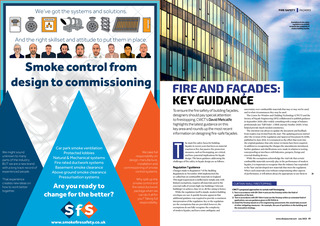


FIRE SAFETY | FAADES Exemptions to fire safety regulations do not fully recognise the complexity of modern building faades FIRE AND FAADES: KEY GUIDANCE To ensure the fire safety of building faades, designers should pay special attention to firestopping. CWCTs David Metcalfe highlights the latest guidance on this key area and rounds up the most recent information on designing fire-safe faades T he main fire safety focus for building faades in recent years has been on material reaction to fire, but passive fire protection measures, such as firestopping, are critical, and have potential implications for faade design. The latest guidance addressing the challenges of fire safety in faade design are as follows: Regulation 7 guidance Changes made to Regulation 7 of the Building Regulations in November 2018 implemented the so-called ban on combustible materials in England. This legal requirement is deliberately simple and, with limited exemptions, requires all materials used in the external walls of certain high-rise buildings (relevant buildings) to achieve class A2-s1, d0 fire rating or better. While the regulation itself is simple, modern building envelopes are not. It quickly became apparent that additional guidance was required to provide a consistent interpretation of the regulation. Key to the regulation are the exemptions that are provided; however, the exemptions do not fully recognise the complexity of modern faades, and leave some ambiguity and uncertainty over combustible materials that may or may not be used, and in what circumstances they may be used. The Centre for Window and Cladding Technology (CWCT) and the Society of Faade Engineering (SFE) collaborated to publish guidance in September 2020, after widely consulting with a range of industry professionals (see Tall Order, CIBSE Journal, October 2020). It has helped provide much-needed consistency. The intention was always to update the document and feedback from readers was invited from the start. The updating process started after the revision of the regulation and Approved Document B (ADB), published in June 2022. It is testament to the effort that went into the original guidance that only minor revisions have been required. In addition to recognising the changes the amendments introduced, further guidance and clarifications were made in relation to testing, waterproofing at interfaces with balconies, parapets, fixings and external shading devices. While the exemptions acknowledge the vital role that certain combustible materials currently play in the performance of modern faades, it is important to recognise that the industry has responded to the ban and developed new materials that meet the regulation. Where such materials exist without compromising other aspects of performance, it will almost always be appropriate to use them in CURTAIN WALL FIRESTOPPING CWCTs proposed approaches to curtain wall firestopping 1. Test in accordance with EN 1364-4 and use the firestop within the field of application of the test. 2. Test in accordance with EN 1364-4 and use the firestop within an extended field of application; can use guidance given in EN 15254-6. 3. Detail the firestop based on a fire engineering assessment; this would take account of other mitigating measures for example, the use of sprinklers in the building and the evacuation strategy. www.cibsejournal.com July 2023 41